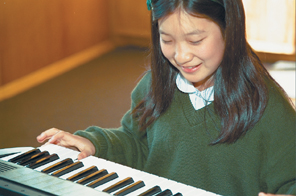![]() CHILDREN’S
ABILITY TO SIGHT-READ MUSIC
CHILDREN’S
ABILITY TO SIGHT-READ MUSIC
![]()
David Sell
The
supposition that children cannot be expected to sight-read music
unless they have a modicum of music-reading skill was put to the
test in this study of children’s sight-reading of music.
The study focused in particular on Year 4 and Year 8 children’s
accuracy in pitch and rhythm while performing sight-singing tasks
from the 1996 NEMP music assessment. |
| Ten percent of the total relevant video-taped performances were selected for analysis, and the original broad NEMP categories used to assess these performances of mostly/always accurate, moderately accurate, and inaccurate/not attempted were further broken down in this study, to make them more specific. For example, in ‘Sing Song’, the pitch element was broken down into pitch correct; pitch sharp; pitch flat; pitch correct, but with some wrong notes; and pitch unrecognisable, or spoken. |  |
| •
A large number of children ‘spoke’ the melody or, if they
sang it, did so at a pitch that was almost unrecognisable. These children
were usually from the same schools, suggesting a paucity of singing
experience/models at home or school. • Where a melody was recognisable, it was invariably sung flat. Sharp singing was virtually absent. • Most of the sight-singing tasks were of melodies set to words. A majority of children could not cope with both reading the words and singing the tune, so abandoned one and tried to do the other, haltingly mumbling the words in a monotone and often eventually giving up altogether. |
•
Children were more likely to read rhythm accurately than pitch. However,
it was the rhythm of the words rather than of the melody that led
to these accurate readings. • Those children who were accurate or near accurate in pitch were generally also accurate or near accurate in rhythm, suggesting that accuracy in one generates accuracy in the other. • Many children settled on a pitch and/or rhythm pattern, though not necessarily the correct one, and repeated it throughout the melody. |
![]()
| •
Words and music should initially be kept separate by focusing on practising
sight-reading wordless melodies. Words have their own rhythm, and
if children learn this type of rhythm first, they find it difficult
to ‘undo’ when the rhythm of the tune and of the words
differ. • Given that most children have difficulty sight-reading rhythm and pitch at the same time, it is important to get the rhythm right first, by clapping, or singing on a single note, and then adding pitch to make the complete melody. • A correct sight-read rhythm generates confidence, and is more likely to lead to a correctly sung pitch melody. |
•
Melody must be set at a reasonable (and not necessarily low) pitch
level. • Singing flat in most cases indicates feeling flat. A buoyant, positive atmosphere is more likely to facilitate in-tune sight-singing. • Sight-singing should not be treated as a right or wrong task. Children given two or three tries on a task nearly always improved, and their confidence grew with each improved attempt. |